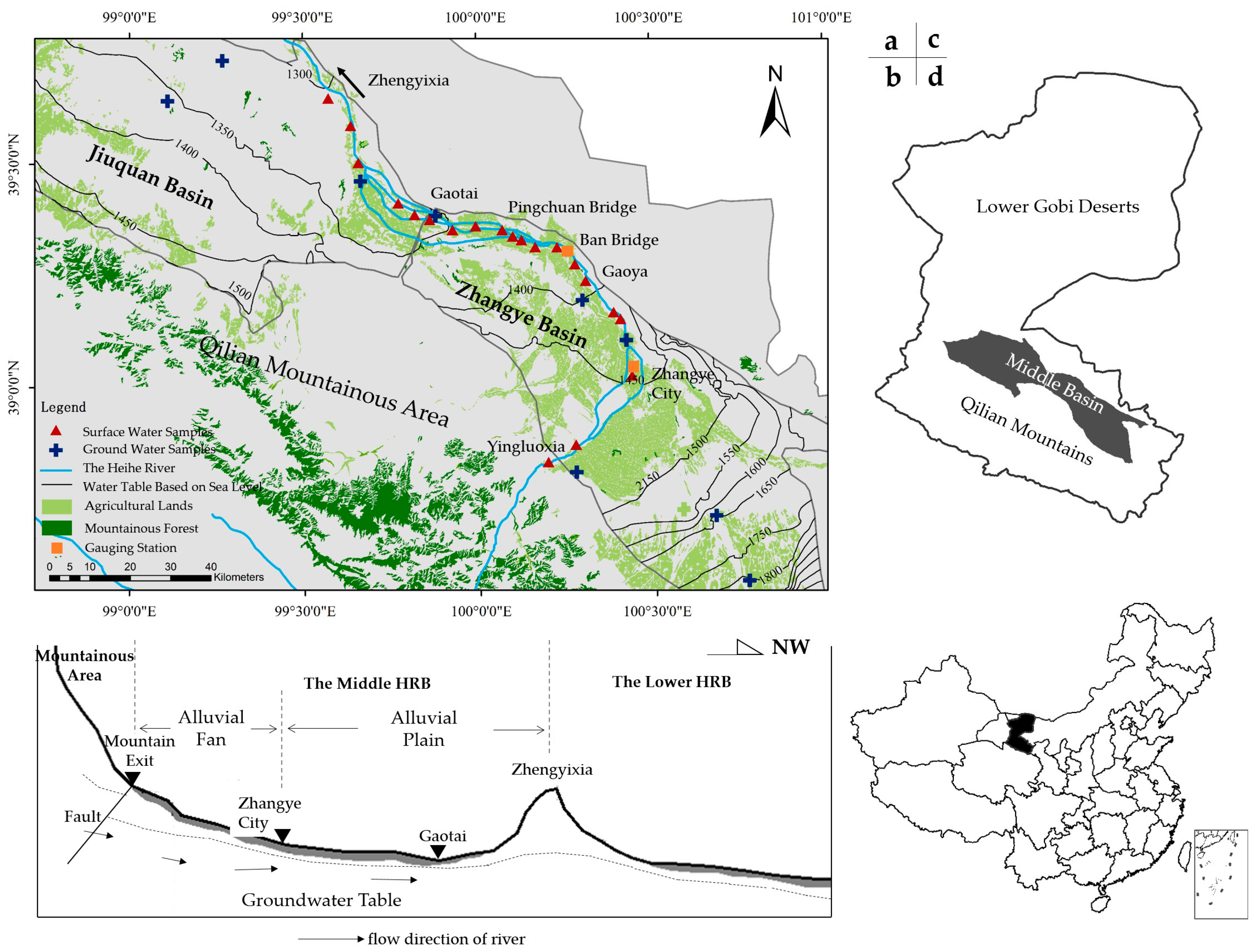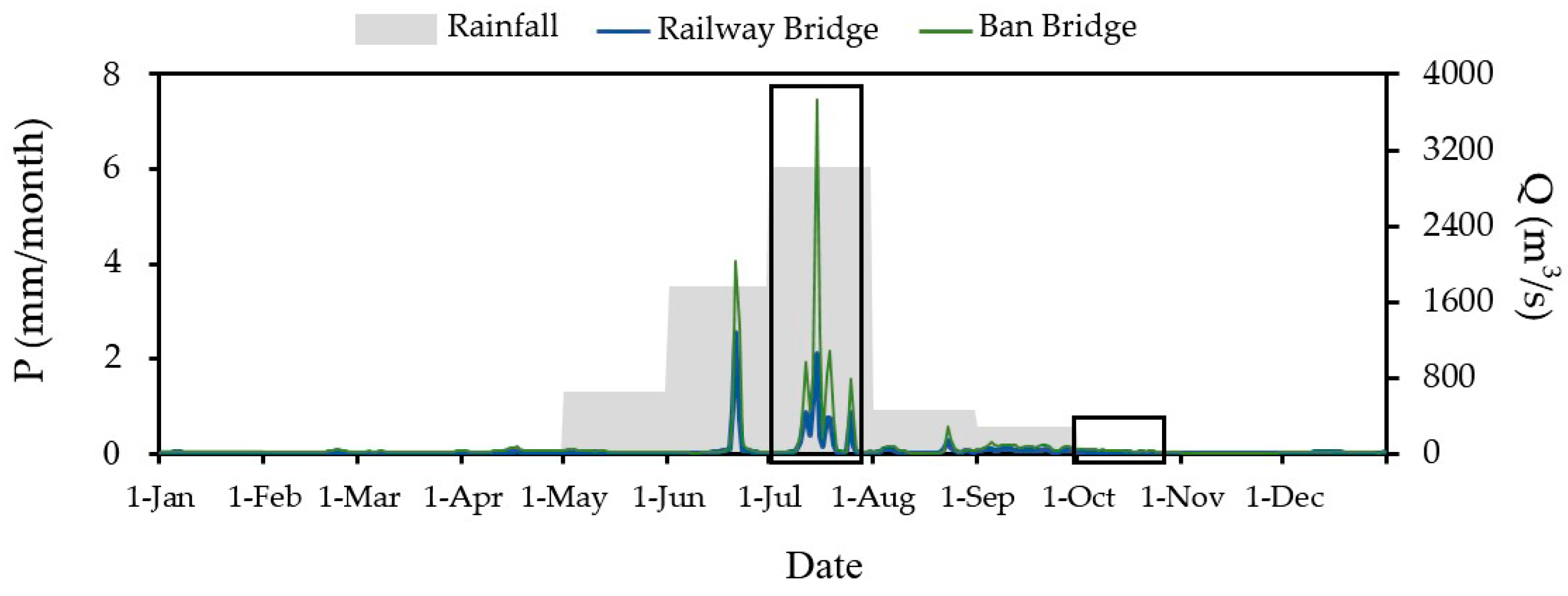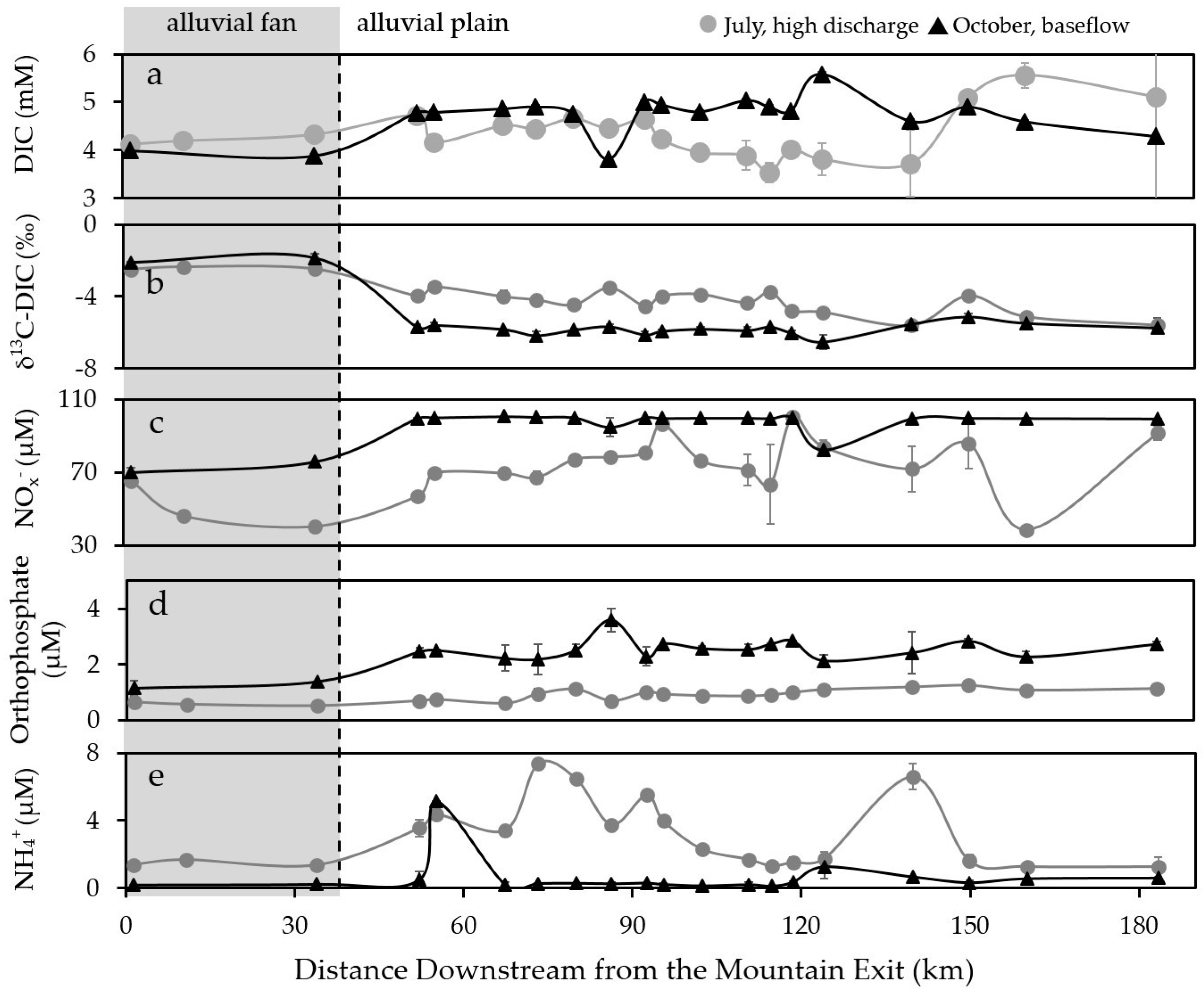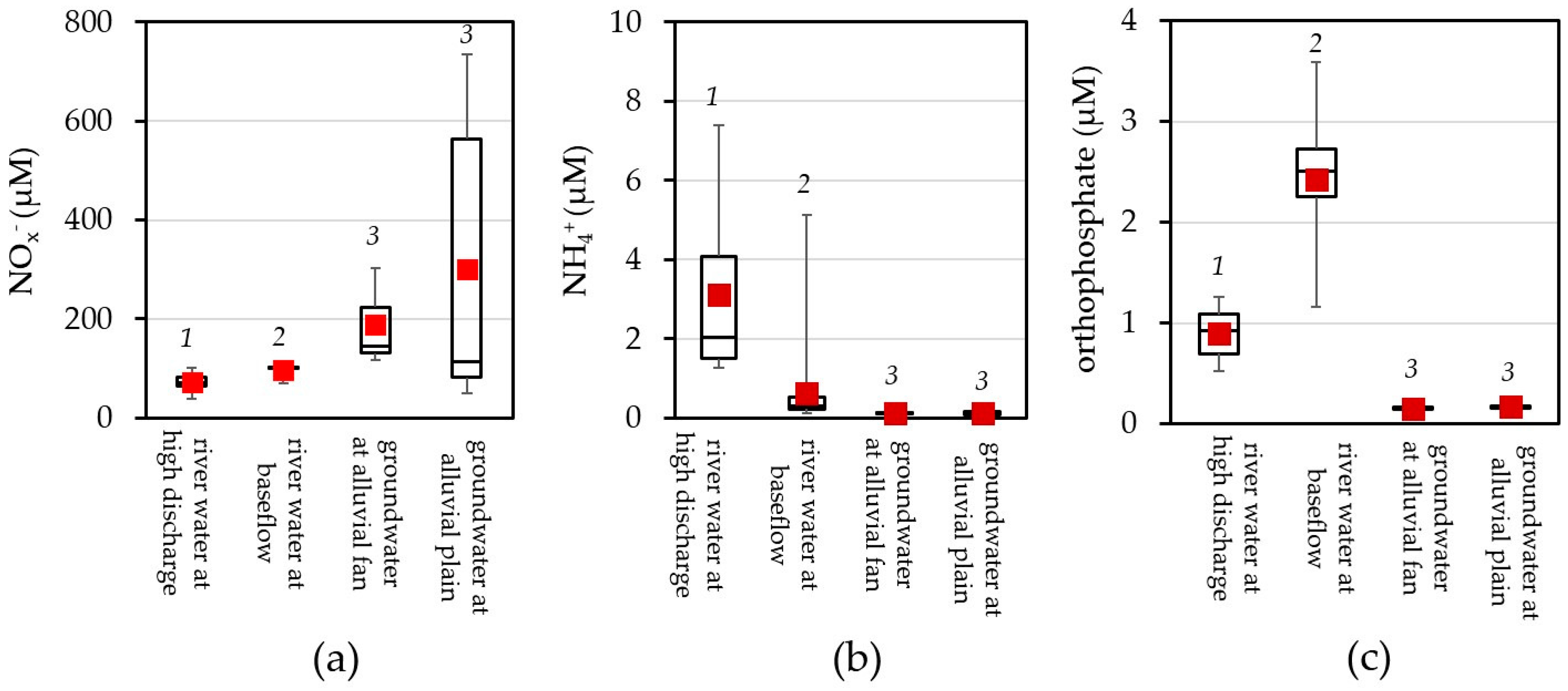Sources and Dynamics of Dissolved Inorganic Carbon, Nitrogen, and Phosphorus in a Large Agricultural River Basin in Arid Northwestern China
Abstract
:1. Introduction
2. Materials and Methods
2.1. Study Sites
2.2. Sample Collection
2.3. Sample Measurement and Data Analysis
3. Results
4. Discussion
4.1. Sources of Dissolved Inorganic Carbon
4.2. Mobilization and Accumulation of Dissolved Inorganic N and P Nutrients
4.3. Hydrological Controls on Riverine Transport of Dissolved Inorganic C, N, and P
4.3.1. River Discharge Controls on Nutrient Export
4.3.2. Groundwater Discharge Controls on River Water DIC and NOx−
4.4. Water Source Mixing Analysis
5. Conclusions and Implications for HRB Watershed Management
- (1)
- Lithogenic carbonate weathering is the primary source of DIC in the river water and groundwater.
- (2)
- Discharge exerted an important control on the amount, source, and flowpath of inorganic C, N, and P mobilized from soils to the river in the middle basin. The majority of ammonium was transported from soils to the river by storm flows, whereas the other nutrients were mobilized through both storm flows and groundwater flows.
- (3)
- Compared with river water, shallow groundwater showed higher DIC concentrations, more negative δ13C-DIC values, and higher NOx− concentrations. This character reflects enhanced carbonate weathering and NOx− accumulation in shallow aquifers due to irrigation practices and fertilizer applications within the middle basin.
- (4)
- The DIC, NOx−-rich shallow groundwater served as a source of nutrients for the Heihe River, whereby the discharge of groundwater into the river regulated the longitudinal variation in DIC and NOx− along the river reach within the alluvial plain. This is because groundwater makes up a significant contribution to river water. The source mixing analysis based on δ13C-DIC and chloride shows that groundwater accounted for 9–34% at high discharge and 39–60% at baseflow.
Acknowledgments
Author Contributions
Conflicts of Interest
References
- Cartwright, I. The origins and behaviour of carbon in a major semi-arid river, the Murray River, Australia, as constrained by carbon isotopes and hydrochemistry. Appl. Geochem. 2010, 25, 1734–1745. [Google Scholar] [CrossRef]
- Brunet, F.; Gaiero, D.; Probst, J.L.; Depetris, P.J.; Lafaye, F.G.; Stille, P. δ13C tracing of dissolved inorganic carbon sources in Patagonian rivers (Argentina). Hydrol. Process. 2005, 19, 3321–3344. [Google Scholar] [CrossRef]
- Jones, J.I.; Young, J.O.; Eaton, J.W.; Moss, B. The influence of nutrient loading, dissolved inorganic carbon and higher trophic levels on the interaction between submerged plants and periphyton. J. Ecol. 2002, 90, 12–24. [Google Scholar] [CrossRef]
- Hu, Y.; Lu, Y.; Edmonds, J.W.; Liu, C.; Wang, S.; Das, O.; Liu, J.; Zheng, C. Hydrological and land use control of watershed exports of DOM in a large arid river basin in northwestern China. J. Geophys. Res. Biogeosci. 2016, 121, 466–478. [Google Scholar] [CrossRef]
- Liu, W.; Xing, M. Isotopic indicators of carbon and nitrogen cycles in river catchments during soil erosion in the arid Loess Plateau of China. Chem. Geol. 2012, 296, 66–72. [Google Scholar] [CrossRef]
- Paerl, H.W.; Valdes, L.M.; Joyner, A.R.; Piehler, M.F.; Lebo, M.E. Solving problems resulting from solutions: Evolution of a dual nutrient management strategy for the eutrophying Neuse River estuary, North Carolina. Environ. Sci. Technol. 2004, 38, 3068–3073. [Google Scholar] [CrossRef] [PubMed]
- Doctor, D.H.; Alexander, E.C., Jr.; Petrič, M.; Kogovšek, J.; Urbanc, J.; Lojen, S.; Stichler, W. Quantification of karst aquifer discharge components during storm events through end-member mixing analysis using natural chemistry and stable isotopes as tracers. Hydrogeol. J. 2006, 14, 1171–1191. [Google Scholar] [CrossRef]
- Raymond, P.A.; Bauer, J.E.; Caraco, N.F.; Cole, J.J.; Longworth, B.; Petsch, S.T. Controls on the variability of organic matter and dissolved inorganic carbon ages in northeast US rivers. Mar. Chem. 2004, 92, 353–366. [Google Scholar] [CrossRef]
- Qin, D.; Qian, Y.; Han, L.; Wang, Z.; Li, C.; Zhao, Z. Assessing impact of irrigation water on groundwater recharge and quality in arid environment using CFCs, tritium and stable isotopes, in the Zhangye Basin, Northwest China. J. Hydrol. 2011, 405, 194–208. [Google Scholar] [CrossRef]
- Cheng, G.; Li, X.; Zhao, W.; Xu, Z.; Feng, Q.; Xiao, S.; Xiao, H. Integrated study of the water–ecosystem–economy in the Heihe River Basin. Natl. Sci. Rev. 2014, 1, 413–428. [Google Scholar] [CrossRef]
- Li, X.; Cheng, G.; Liu, S.; Xiao, Q.; Ma, M.; Jin, R.; Che, T.; Liu, Q.; Wang, W.; Qi, Y. Heihe Watershed Allied TelemetryExperimental Research (HiWATER): Scientific objectives and experimental design. Bull. Am. Meteorol. Soc. 2013, 94, 1145–1160. [Google Scholar] [CrossRef]
- Jiang, P.; Cheng, L.; Li, M.; Zhao, R.; Duan, Y. Impacts of LUCC on soil properties in the riparian zones of desert oasis with remote sensing data: A case study of the middle Heihe River Basin, China. Sci. Total Environ. 2015, 506, 259–271. [Google Scholar] [CrossRef] [PubMed]
- Wang, Q.; Li, F.; Zhao, L.; Zhang, E.; Shi, S.; Zhao, W.; Song, W.; Vance, M.M. Effects of irrigation and nitrogen application rates on nitrate nitrogen distribution and fertilizer nitrogen loss, wheat yield and nitrogen uptake on a recently reclaimed sandy farmland. Plant Soil 2010, 337, 325–339. [Google Scholar] [CrossRef]
- Johnson, D.; Susfalk, R.; Dahlgren, R.; Klopatek, J. Fire is more important than water for nitrogen fluxes in semi-arid forests. Environ. Sci. Policy 1998, 1, 79–86. [Google Scholar] [CrossRef]
- Chen, Z.; Nie, Z.; Zhang, G.; Wan, L.; Shen, J. Environmental isotopic study on the recharge and residence time of groundwater in the Heihe River Basin, Northwestern China. Hydrogeol. J. 2006, 14, 1635–1651. [Google Scholar] [CrossRef]
- Zhang, Y.H.; Song, X.F.; Wu, Y.Q. Use of oxygen-18 isotope to quantify flows in the upriver and middle reaches of the Heihe River, Northwestern China. Environ. Geol. 2009, 58, 645–653. [Google Scholar] [CrossRef]
- Yang, Q.; Xiao, H.; Zhao, L.; Yang, Y.; Li, C.; Zhao, L.; Yin, L. Hydrological and isotopic characterization of river water, groundwater, and groundwater recharge in the Heihe River Basin, Northwestern China. Hydrol. Process. 2011, 25, 1271–1283. [Google Scholar] [CrossRef]
- Zhang, G.; Liu, S.; Xie, Y.; Chen, Z.; Zhang, C.; Wu, Y.; Wu, Q.; Nie, Z.; Shen, J.; Xu, G.; et al. Water Circulation and Groundwater Evolution Pattern in the Endorheic Heihe River Basin, Northwestern China, 1st ed.; Geological Publishing House: Beijing, China, 2005. [Google Scholar]
- LaCroix, R.; Keeney, D.; Walsh, L. Potentiometric titration of chloride in plant tissue extracts using the chloride ion electrode. Commun. Soil Sci. Plant Anal. 1970, 1, 1–6. [Google Scholar] [CrossRef]
- Das, A.; Krishnaswami, S.; Bhattacharya, S. Carbon isotope ratio of dissolved inorganic carbon (DIC) in rivers draining the Deccan Traps, India: Sources of DIC and their magnitudes. Earth Planet. Sci. Lett. 2005, 236, 419–429. [Google Scholar] [CrossRef]
- Akoko, E.; Atekwana, E.A.; Cruse, A.M.; Molwalefhe, L.; Masamba, W.R. River-wetland interaction and carbon cycling in a semi-arid riverine system: The Okavango Delta, Botswana. Biogeochemistry 2013, 114, 359–380. [Google Scholar] [CrossRef]
- Meybeck, M. Global chemical weathering of surficial rocks estimated from river dissolved loads. Am. J. Sci. 1987, 287, 401–428. [Google Scholar] [CrossRef]
- Sage, R.F.; Monson, R.K. C4 Plant Biology; Academic Press: San Diego, CA, USA, 1999. [Google Scholar]
- Mu, C.; Zhang, T.; Wu, Q.; Cao, B.; Zhang, X.; Peng, X.; Wan, X.; Zheng, L.; Wang, Q.; Cheng, G. Carbon and nitrogen properties of permafrost over the Eboling Mountain in the upper reach of Heihe River Basin, Northwestern China. Arct. Antarct. Alp. Res. 2015, 47, 203–211. [Google Scholar] [CrossRef]
- Cao, G.; Zheng, C.; Simmons, C.T. Groundwater recharge and mixing in arid and semiarid regions: Heihe River Basin, Northwest China. Acta Geol. Sin. 2016, 90, 971–987. [Google Scholar]
- Yao, Y.; Zheng, C.; Liu, J.; Cao, G.; Xiao, H.; Li, H.; Li, W. Conceptual and numerical models for groundwater flow in an arid inland river basin. Hydrol. Process. 2014, 29, 1480–1492. [Google Scholar] [CrossRef]
- Sher, Y.; Zaady, E.; Ronen, Z.; Nejidat, A. Nitrification activity and levels of inorganic nitrogen in soils of a semi-arid ecosystem following a drought-induced shrub death. Eur. J. Soil Biol. 2012, 53, 86–93. [Google Scholar] [CrossRef]
- Robertson, G.; Groffman, P. Nitrogen transformations. In Soil Microbiology, Ecology, and Biochemistry, 4th ed.; Paul, G., Ed.; Academic Press: Burlington, MA, USA, 2007; pp. 341–364. [Google Scholar]
- McCarthy, J.J.; Taylor, W.R.; Taft, J.L. Nitrogenous nutrition of the plankton in the Chesapeake Bay. 1. Nutrient availability and phytoplankton preferences. Limnol. Oceanogr. 1977, 22, 996–1011. [Google Scholar] [CrossRef]
- Verhoeven, J.; Arts, H. Nutrient dynamics in small mesotrophic fens surrounded by cultivated land. II. N and P accumulation in plant biomass in relation to the release of inorganic N and P in the peat soil. Oecologia 1987, 72, 557–561. [Google Scholar] [CrossRef] [PubMed]
- Boy, J.; Valarezo, C.; Wilcke, W. Water flow paths in soil control element exports in an Andean tropical montane forest. Eur. J. Soil Sci. 2008, 59, 1209–1227. [Google Scholar] [CrossRef]
- Wu, B.; Zheng, Y.; Tian, Y.; Wu, X.; Yao, Y.; Han, F.; Liu, J.; Zheng, C. Systematic assessment of the uncertainty in integrated surface water-groundwater modeling based on the probabilistic collocation method. Water Resour. Res. 2014, 50, 5848–5865. [Google Scholar] [CrossRef]
- Lecher, A.L.; Fisher, A.T.; Paytan, A. Submarine groundwater discharge in Northern Monterey Bay, California: Evaluation by mixing and mass balance models. Mar. Chem. 2016, 179, 44–55. [Google Scholar] [CrossRef]
- Young, M.B.; Gonneea, M.E.; Fong, D.A.; Moore, W.S.; Herrera-Silveira, J.; Paytan, A. Characterizing sources of groundwater to a tropical coastal lagoon in a karstic area using radium isotopes and water chemistry. Mar. Chem. 2008, 109, 377–394. [Google Scholar] [CrossRef]
- Lu, Y.H.; Bauer, J.E.; Canuel, E.A.; Chambers, R.M.; Yamashita, Y.; Jaffé, R.; Barrett, A. Effects of land use on sources and ages of inorganic carbon in temperate headwater streams. Biogeochemistry 2014, 119, 275–292. [Google Scholar] [CrossRef]
- Zeng, F.W.; Masiello, C.A.; Hockaday, W.C. Controls on the origin and cycling of riverine dissolved inorganic carbon in the Brazos River, Texas. Biogeochemistry 2011, 104, 275–291. [Google Scholar] [CrossRef]
- Schmidt, S.; Geyer, T.; Marei, A.; Guttman, J.; Sauter, M. Quantification of long-term wastewater impacts on karst groundwater resources in a semi-arid environment by chloride mass balance methods. J. Hydrol. 2013, 502, 177–190. [Google Scholar] [CrossRef]
- Qian, Y.; Wang, L. Applications of Isotope Hydrology Technology in Researches of Water Cycles in the Heihe River Basin, 1st ed.; Yellow River Conservancy Press: Zhengzhou, China, 2008. [Google Scholar]
- Ohte, N.; Dahlgren, R.A.; Silva, S.R.; Kendall, C.; Kratzer, C.R.; Doctor, D.H. Sources and transport of algae and nutrients in a Californian river in a semi-arid climate. Freshw. Biol. 2007, 52, 2476–2493. [Google Scholar] [CrossRef]
- Lamontagne, S.; Leaney, F.W.; Herczeg, A.L. Patterns in groundwater nitrogen concentration in the riparian zone of a large semi-arid river (River Murray, Australia). River Res. Appl. 2006, 22, 39–54. [Google Scholar] [CrossRef]
- Hadwen, W.L.; Fellows, C.S.; Westhorpe, D.P.; Rees, G.N.; Mitrovic, S.M.; Taylor, B.; Baldwin, D.S.; Silvester, E.; Croome, R. Longitudinal trends in river functioning: Patterns of nutrient and carbon processing in three Australian rivers. River Res. Appl. 2010, 26, 1129–1152. [Google Scholar] [CrossRef]
- Varol, M. Temporal and spatial dynamics of nitrogen and phosphorus in surface water and sediments of a transboundary river located in the semi-arid region of Turkey. Catena 2013, 100, 1–9. [Google Scholar] [CrossRef]
- World Health Organization (WHO). Guidelines for Drinking-Water Quality, 4th ed.; WHO Press: Geneva, Switzerland, 2011. [Google Scholar]
- Vollenweider, R.; Kerekes, J. Eutrophication of Waters. Monitoring, Assessment and Control, 1st ed.; Organization for Economic Co-Operation and Development (OECD): Paris, France, 1982. [Google Scholar]








| Tracer | fg at Gaoya * (%) | fg at Gaotai * (%) | Source | |
|---|---|---|---|---|
| High Discharge | δ13C-DIC + Cl− | 9–18 | 24–34 | The present study |
| δ18O | 20–30 a; 23.6 b | 55–75 a; 60.3 b | a Zhang et al., 2005 [18]; b Zhang et al., 2009 [16]; | |
| Baseflow | δ13C-DIC + Cl− | 39–44 | 51–60 | The present study |
| δ18O | 25–45 a | 70–80 a | a Zhang et al., 2005 [18]; b Zhang et al., 2009 [16]; | |
© 2017 by the authors. Licensee MDPI, Basel, Switzerland. This article is an open access article distributed under the terms and conditions of the Creative Commons Attribution (CC BY) license (http://creativecommons.org/licenses/by/4.0/).
Share and Cite
Hu, Y.; Lu, Y.; Liu, C.; Shang, P.; Liu, J.; Zheng, C. Sources and Dynamics of Dissolved Inorganic Carbon, Nitrogen, and Phosphorus in a Large Agricultural River Basin in Arid Northwestern China. Water 2017, 9, 415. https://doi.org/10.3390/w9060415
Hu Y, Lu Y, Liu C, Shang P, Liu J, Zheng C. Sources and Dynamics of Dissolved Inorganic Carbon, Nitrogen, and Phosphorus in a Large Agricultural River Basin in Arid Northwestern China. Water. 2017; 9(6):415. https://doi.org/10.3390/w9060415
Chicago/Turabian StyleHu, Yue, Yuehan Lu, Chuankun Liu, Peng Shang, Jie Liu, and Chunmiao Zheng. 2017. "Sources and Dynamics of Dissolved Inorganic Carbon, Nitrogen, and Phosphorus in a Large Agricultural River Basin in Arid Northwestern China" Water 9, no. 6: 415. https://doi.org/10.3390/w9060415





